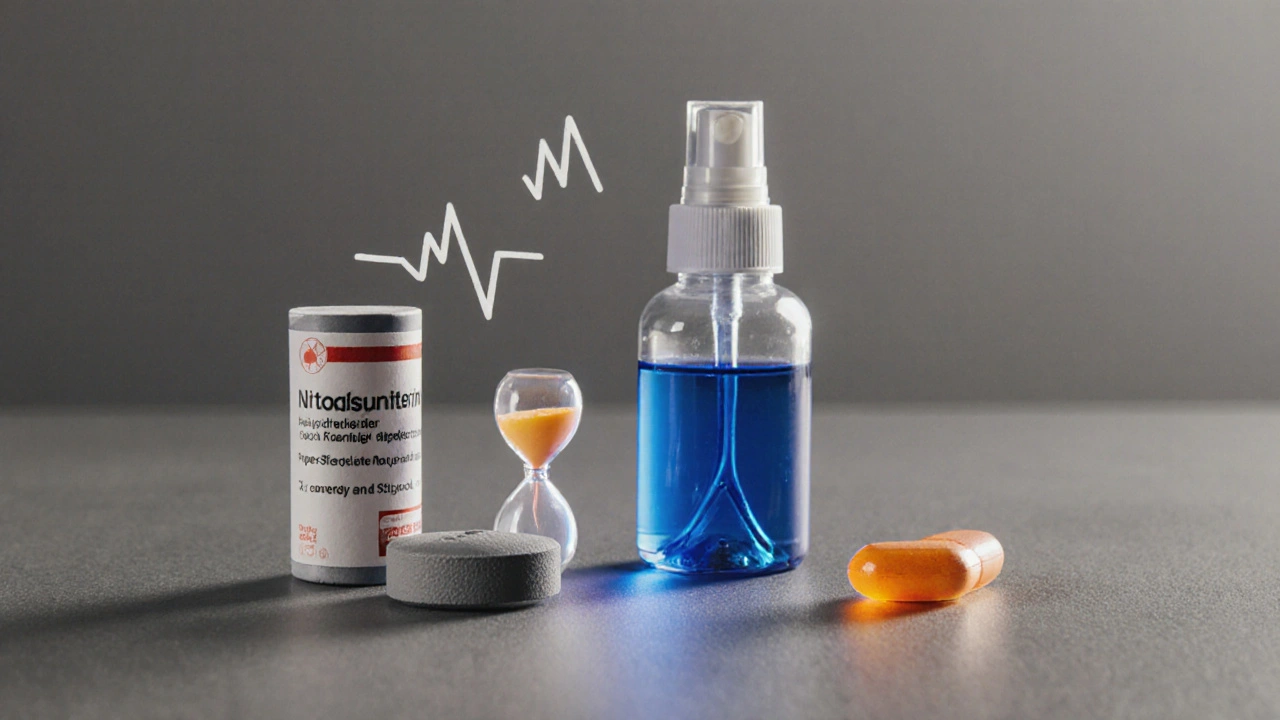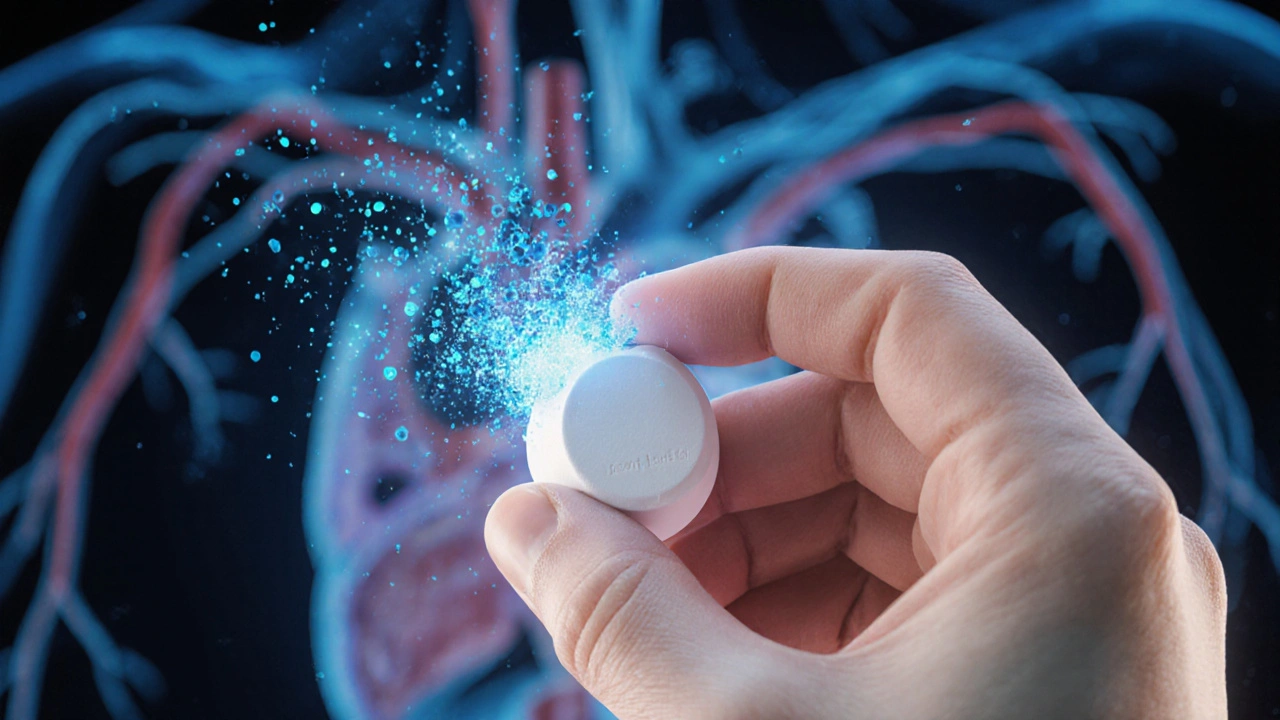Angina Medication Decision Tool
Select Your Key Factors
Recommended Medication Type
This recommendation is based on your selected factors. Always consult your healthcare provider before making medication changes.
Important Safety Information
Key Takeaways
- Isordil (isosorbide dinitrate) is a long‑acting nitrate that relieves chest pain by relaxing blood vessels.
- Common alternatives include isosorbide mononitrate, nitroglycerin, beta‑blockers (e.g., metoprolol) and calcium‑channel blockers (e.g., amlodipine).
- Choose a replacement based on onset speed, dosing convenience, side‑effect profile, and any co‑existing conditions.
- Watch for nitrate tolerance and drug interactions, especially with phosphodiesterase‑5 inhibitors.
- Always discuss switching drugs with a healthcare professional to tailor therapy to your needs.
What Is Isordil and How Does It Work?
When you first see the name Isordil is a brand name for isosorbide dinitrate, a long‑acting nitrate used to prevent angina pectoris, the question is usually: why does a pill that looks like a regular tablet stop my chest pain?
Isosorbide dinitrate releases nitric oxide inside the walls of arteries and veins. Nitric oxide triggers vasodilation is the widening of blood vessels, which lowers heart‑work and improves oxygen delivery to the heart muscle. The result is less strain on the coronary arteries, which means fewer angina attacks.
Because it is long‑acting, Isordil is usually taken at regular intervals (often twice a day). This steady release helps keep blood vessels relaxed over the whole day, but it also means tolerance can develop if you don’t include a nitrate‑free interval.
Major Alternatives on the Market
Not everyone tolerates Isordil well, and some doctors prefer a different class of drug. Below are the most frequently prescribed options.
- Isosorbide mononitrate is a single‑nitrate formulation that provides smoother plasma levels and less daytime headache than the dinitrate.
- Nitroglycerin is a fast‑acting nitrate available as tablets, sprays, or patches, used for immediate relief of angina episodes.
- Metoprolol is a beta‑blocker that reduces heart rate and contractility, lowering oxygen demand.
- Amlodipine is a calcium‑channel blocker that relaxes arterial smooth muscle and improves coronary blood flow.
Each alternative belongs to a different pharmacologic class, which means they have distinct benefits, drawbacks, and suitability depending on your overall health.

Comparison Table: Isordil vs. Popular Alternatives
| Drug | Class | Typical Dose Form | Onset | Duration | Common Side Effects | Best For |
|---|---|---|---|---|---|---|
| Isordil | Nitrate (long‑acting) | Oral tablet | 30-60 min | 6-12 hrs | Headache, dizziness, flushing | Patients needing steady prophylaxis |
| Isosorbide Mononitrate | Nitrate (single) | Oral tablet | 45-60 min | 12-24 hrs | Less headache, occasional hypotension | Those who experience frequent Isordil headaches |
| Nitroglycerin | Nitrate (short‑acting) | SL tablet, spray, patch | 1-3 min (SL) | 15-30 min (SL) | Severe headache, tachyphylaxis | Immediate relief of acute angina attacks |
| Metoprolol | Beta‑blocker | Oral tablet | 1-2 hrs | 12 hrs (extended‑release) | Bradycardia, fatigue, cold hands | Patients with hypertension or post‑MI |
| Amlodipine | Calcium‑channel blocker | Oral tablet | 2-4 hrs | 24 hrs | Peripheral edema, gum hyperplasia | Those with concurrent hypertension or Raynaud’s |
How to Choose the Right Option for You
Switching from Isordil to an Isordil alternatives isn’t a one‑size‑fits‑all decision. Consider these practical checkpoints:
- Speed of Relief: If you need rapid relief during a flare‑up, nitroglycerin’s sublingual spray beats any oral tablet.
- Dosage Convenience: Once‑daily mononitrate or a beta‑blocker can simplify routines compared to twice‑daily Isordil.
- Side‑Effect Tolerance: Headaches are classic nitrate complaints. Mononitrate usually causes fewer, while beta‑blockers may lead to fatigue.
- Co‑existing Conditions: Diabetes patients on beta‑blockers must monitor low blood sugar symptoms; calcium‑channel blockers can worsen heart block in some arrhythmias.
- Potential Interactions: Nitrates and phosphodiesterase‑5 inhibitors (Viagra, Cialis) can trigger dangerous drops in blood pressure. Beta‑blockers interact with asthma medications.
Write down your daily schedule, current meds, and any adverse reactions. Bring this list to your physician - it makes the conversation concrete and speeds up the decision.
Safety, Tolerance, and Drug Interactions
Nitrate tolerance is a phenomenon where the body becomes less responsive to nitrates after continuous exposure, reducing their effectiveness. The classic way to prevent it is a nightly nitrate‑free window (usually 8-12 hours). If you miss that window, you might notice that Isordil no longer stops the pain as well.
When swapping to another nitrate (like mononitrate), the same tolerance principle applies. However, moving to a non‑nitrate class (beta‑blocker or calcium‑channel blocker) eliminates the tolerance issue altogether.
Key interaction warnings:
- Never combine any nitrate with phosphodiesterase‑5 inhibitors (Viagra®, Cialis®). The combo can cause a sudden systolic drop below 90mmHg.
- Beta‑blockers should be used cautiously with insulin or sulfonylureas because they can mask hypoglycemia signs.
- Amlodipine can increase blood levels of certain antibiotics (e.g., clarithromycin) - dose adjustments may be needed.
Always list every supplement, over‑the‑counter drug, and prescription medicine with your clinician before changing therapy.

Real‑World Scenarios
Scenario 1 - Persistent Headaches: Jane, 58, reports daily throbbing headaches after taking Isordil. Her doctor switches her to isosorbide mononitrate 60mg once daily. After two weeks, headaches drop from 7/10 to 2/10, and her angina frequency stays the same.
Scenario 2 - Need for Immediate Rescue: Mark, 65, experiences occasional sudden chest pain during gardening. His baseline therapy is Isordil, but he adds a sublingual nitroglycerin tablet for instant relief. He learns to keep the tablet in his pocket and uses it within minutes of pain onset, avoiding emergency visits.
Scenario 3 - Coinciding Hypertension: Luis, 70, has controlled angina on Isordil but also suffers high blood pressure. His doctor swaps to amlodipine 5mg daily, which both lowers his BP and prevents angina by improving coronary flow. He reports mild ankle swelling, which is managed by a low‑dose diuretic.
Next Steps and Troubleshooting
If you decide to move away from Isordil, follow this checklist:
- Schedule an appointment with your cardiologist or primary care provider.
- Bring a list of all current meds, supplements, and any side‑effects you’ve noticed.
- Ask about the titration schedule for the new drug - many alternatives start low and increase gradually.
- Set a reminder for a nitrate‑free period if you stay on any nitrate.
- Monitor blood pressure and heart rate for the first two weeks; note any new symptoms.
If you experience dizziness, fainting, or a sudden increase in chest pain after a switch, seek medical attention immediately - these could signal an under‑dosed regimen or a harmful interaction.
Frequently Asked Questions
Can I take Isordil and nitroglycerin together?
Both are nitrates, so using them together increases the risk of severe low blood pressure and headache. Doctors may prescribe a short‑acting nitroglycerin for breakthrough pain while you stay on a long‑acting nitrate, but dosage timing must be carefully managed.
Isosorbide mononitrate work as well as Isordil?
Yes, mononitrate provides similar vasodilatory effect but with smoother blood levels, which usually means fewer headaches and a simpler once‑daily schedule.
What should I do if I miss a dose of Isordil?
Take the missed tablet as soon as you remember, unless it’s close to your next scheduled dose. In that case, skip the missed dose and resume the regular timing to avoid double‑dosing.
Are beta‑blockers safe for patients with asthma?
Cardio‑selective beta‑blockers like metoprolol are generally safer, but they still carry a risk of bronchospasm. Discuss inhaler use and lung function tests with your doctor before starting.
How long does it take for tolerance to develop?
Tolerance can begin within a few days of continuous nitrate use, especially if you don’t have a nitrate‑free interval each night.


Comments
Rushikesh Mhetre
Hey everyone! If you’re juggling Isordil and thinking about swapping, start by jotting down how often you get headaches and whether you need quick relief or just prevention. That list will make the doctor’s job way easier! 💪
October 14, 2025 at 18:21
Sharath Babu Srinivas
Great rundown! 👍 Just a heads‑up: watch out for the nitrate‑free window; missing it can spike those pesky headaches. Also, emojis aren’t just for fun – they remind us to keep things light! 😊
October 23, 2025 at 10:41
Halid A.
For patients concerned about both angina prevention and occasional breakthrough attacks, a combined strategy often works best: a long‑acting nitrate such as isosorbide mononitrate for baseline control, supplemented with a sublingual nitroglycerin tablet for acute episodes. This approach maintains steady vasodilation while providing rapid relief when needed.
November 1, 2025 at 02:01
Brandon Burt
Well, technically speaking, the literature suggests that the efficacy of a combined regimen hinges on strict timing to avoid nitrate tolerance; indeed, patients should observe a nightly nitrate‑free interval of at least eight hours, otherwise the therapeutic benefits may diminish considerably. Moreover, the pharmacokinetic profile of isosorbide mononitrate offers a more consistent plasma concentration, which can mitigate the frequency of headache episodes that are commonly associated with Isordil. Nevertheless, clinicians must remain vigilant regarding potential drug interactions, especially with phosphodiesterase‑5 inhibitors, as concomitant use can precipitate severe hypotension; therefore, a thorough medication reconciliation is indispensable. In practice, I've found that patient education on proper dosing intervals dramatically improves adherence and outcomes.
November 9, 2025 at 18:21
Gloria Reyes Najera
Listen up folks, this whole nitrate thing is not some exotic foreign remedy, it’s plain old American pharma that’s been around forever and most of y’all are just scared of a little headache. Isordil works fine if you take it right, once a day, no drama. The real problem is you keep popping the same dose every single day, so your body gets used to it and the drug stops working – that’s what they call tolerance, not some mystical curse. Stop being a whiner about the side effects and ask your doc to give you a nitrate‑free night, that’s the trick. If you’re on any Viagra or Cialis, DO NOT even think about taking nitrates – you’ll drop to half your blood pressure, you’ll pass out, end of story. A lot of you think beta blockers are a magic bullet, but they can make you feel like a dead battery, especially if you have asthma – they’ll tighten your airways, not relax them. Amlodipine? Yeah, it can cause ankle swelling, but that’s manageable with a diuretic, not a reason to quit your meds. The bottom line – stick to the schedule, watch the interactions, and if you get a pounding headache, switch to isosorbide mononitrate – it gives the same relief with less pounding. Don’t be a puppet of the internet, read the label, follow the doctor's advice, and you’ll keep your chest pain under control without drama.
November 18, 2025 at 10:41
Gauri Omar
Whoa, slow down! You’re throwing a lot at once – but hear me out: if you’re already battling headaches with Isordil, the mononitrate can be a game‑changer because it releases nitric oxide more evenly, cutting down that throbbing. Yet, don’t ignore the fact that any nitrate still demands that nightly gap; otherwise, you’ll just chase your tail with tolerance. And yes, beta‑blockers can be a nightmare for asthma patients – the bronchoconstriction risk isn’t a myth. So, when you’re weighing options, think about your whole health picture, not just the chest pain. At the end of the day, a tailored plan beats a one‑size‑fits‑all approach.
November 27, 2025 at 03:01
Willy garcia
If you’re unsure which drug fits your lifestyle, try listing out your daily routine and match it with dosing frequency – once‑daily meds are great for busy weeks, while twice‑daily options might give smoother coverage. Always double‑check for interactions, especially with PDE‑5 inhibitors.
December 5, 2025 at 19:21
zaza oglu
Yo! 🌈 Let’s make this fun: picture your heart as a stubborn DJ refusing to drop the beat. Nitrates are the vinyl that makes the crowd (your arteries) dance! If the DJ’s stuck on one track (tolerance), swap the record – try mononitrate or a beta‑blocker remix. Just don’t slam the volume with Viagra at the same time or the whole club crashes. 🎧
December 14, 2025 at 11:41
Vaibhav Sai
Okay, quick grammar tip while we’re at it: when you write “Isordil’s side‑effects include headaches, dizziness, and flushing,” don’t forget the Oxford comma if you want extra clarity – but if you’re a minimalist, you can skip it. Also, remember to italicize drug names for emphasis in your notes!
December 23, 2025 at 04:01